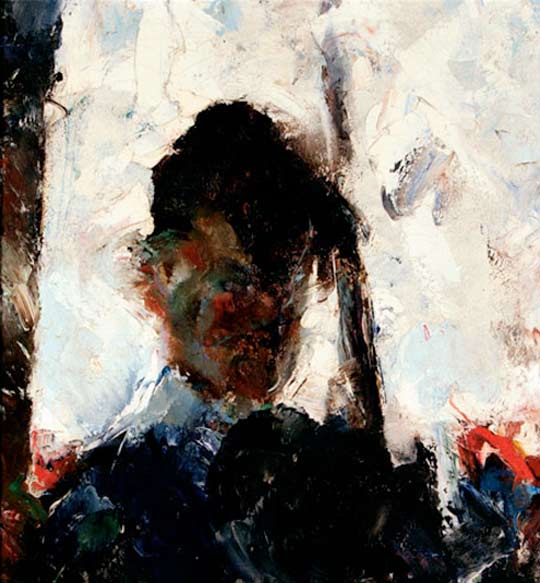
1914 Self Portrait in a Fur Hat
For painters who work from observation there are few greater painters to study or get inspiration from than Edwin Dickinson. (Born NY: 1891 Died: 1978) When I was in art school in the mid 80’s my painting teacher,
George Nick – a former student of Edwin Dickinson, frequently discussed Dickinson’s work and manner of teaching. I was smitten by his modern, painterly approach that seemed to meld classical painting with abstract expressionism. His masterful painting, enigmatic subject matter, and expressive style gives him the ultimate “painter’s painter” status. Sadly, too many painters I have talked to, especially younger painters, have heard very little or nothing about him. Over the past few years this has been changing. Hopefully, I can provide some information here that might be useful to someone wanting to know more about him and his work.

The Book, 1911 Oil on canvas laid on masonite 9″ x 23″
Despite his being one of America’s greatest painters few people outside of certain circles in the art world has ever heard of him. There used to be very little information available on him. However, there is now a wealth of information for Dickinson fans – since the advent of Google, the “Dreams and Realities” traveling musuem show, organized by the Albright-Knox Gallery in Buffalo, New York 2002-3 (which I was fortunate to see in Lincoln, NE), the 2004 book by John L. Ward Edwin Dickinson: A Critical History of His Paintings, and numerous websites with articles and images can now be had.
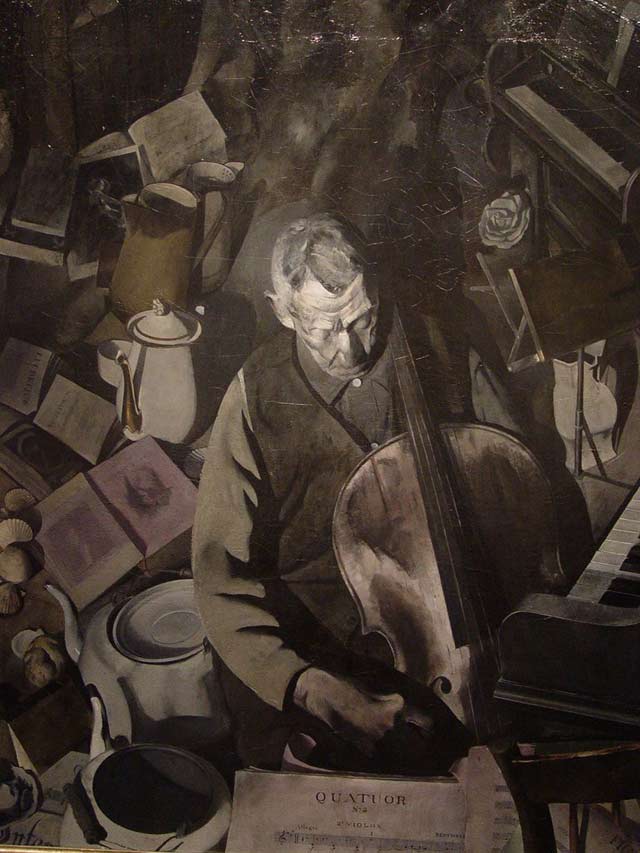
The Cello Player 1924 – 1926 60″ x 48″
Dickinson, who studied with both William Merrit Chase and Charles Hawthorne, is known for his large “machines” paintings like the cello player above, involving the figure, still-life from both observation and invention – many with mysterious dark subject matter. He also made some 230 premier coup paintings out of 431 documented paintings, that is to say paintings done from life in one-sitting in a direct manner. He was reported to walk all over the Provincetown, Cape Cod area – as much as 40 miles a day, in looking for the right motif to paint. One curious aspect of his painting was that his concentration was sometimes so intense that his would forget what type of painting he was making – painting a figure or a still-life, or confuse the landscape with the painting. This article by Mary Ellen Abell suggests that this tendency might have come from his study with William Merritt Chase, “who reportedly used to suggest that his students try to conceive of their canvases as the reality and the motif as the painting.”
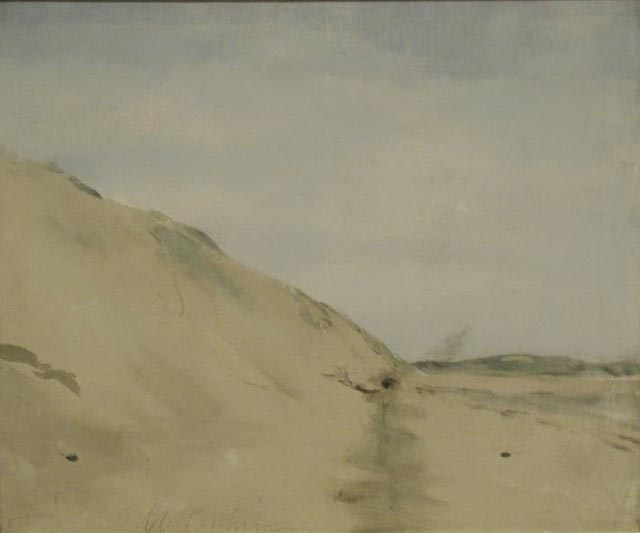
Laboratory Beach 1935

Cove, Wellfleet 1946
You can read for free parts of the 2004 book by John L. Ward Edwin Dickinson: A Critical History of His Paintings, here – lots of interesting information. Seems very comprehensive and I’m ordering the book and hope to write a review of the book in the future. You can get this book from Amazon here.
If you haven’t yet seen the catalog to the Dreams and Realities show then you’re in for a major treat. 72 full color reproductions and 91 black/white illustrations and is this is the first major book in 20 years on his work. Check it out on Amazon here
A wonderful article written by Mary Ellen Abell who curated the Provincetown Art Association Musuem’s (PAAM) 2007 exhibition Edwin Dickinson: The Provincetown Years, 1912-1937, discussed his work more from a painter’s perspective, in other words has some very intelligent things to say! Well worth following the link here. She also wrote an essay in the Dreams and Realities Catalog on “the Teaching of Edwin Dickinson, An Overview and Glossary” that you can read on google books for free here. If the link breaks just try googling Mary Ellen Abell.
a good review and informative article about Dickinson and the PAAM show by John Yau at the Brooklyn Rail is here.
There is a catalog to the PAAM show but I couldn’t find it on their website but they had a number of other catalogs that may be of interest – like ones on Charles Hawthorne and an earlier catalog on Dickinson.
There is also a video podcast about this show and Edwin Dickinson that will be of interest, a number of interesting photos of Dickinson and his classes. You can watch it here.
Also here is another article has a number of images and information from that show that may be of interest.
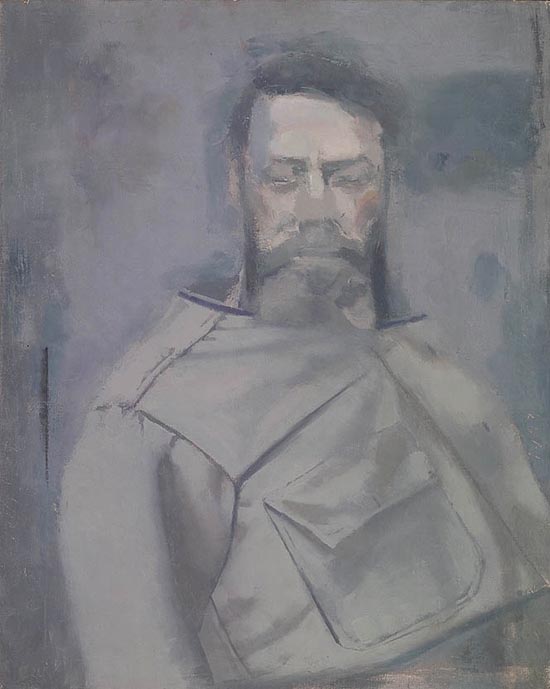
Self-Portrait in Gray Shirt 1943
Here is another great resource – from the man himself. Transcripts from an interview with Edwin W. Dickinson in 1962 by a Dorothy Seckler and is on the Archives of American Art, Smithsonian Institution website. Read it here.
Also, an obvious but very helpful way to get more information on him is to simply google Edwin Dickinson in google images.
As time and opportunity permits I will try to post more information and links on Edwin Dickinson.
In the mean time here are a few of his paintings I’ve found online that I wanted to share.
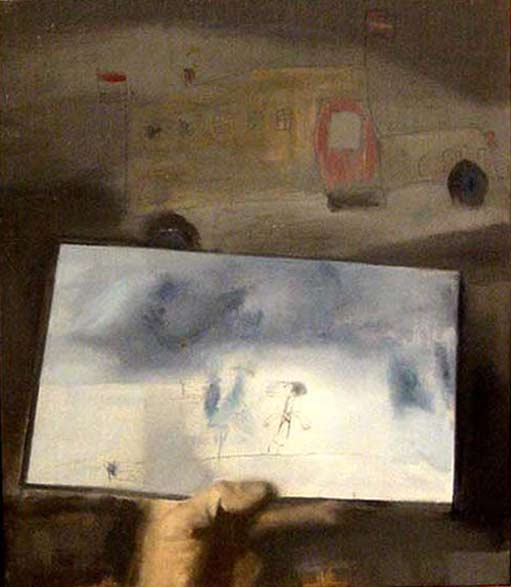
The Artist’s Hand Holding Children’s Drawings 1940
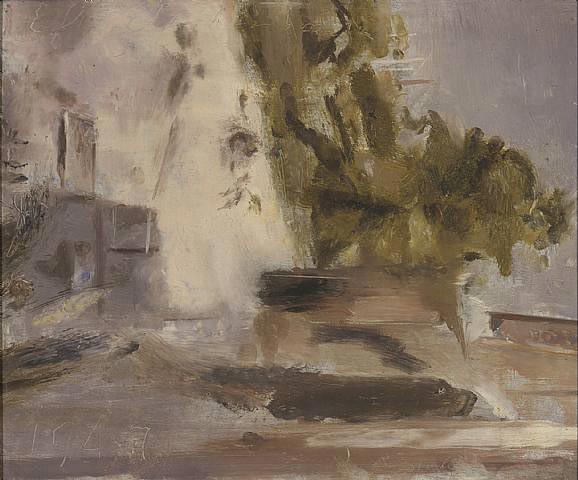
Studio Wellfleet 1947 10″ x 12″
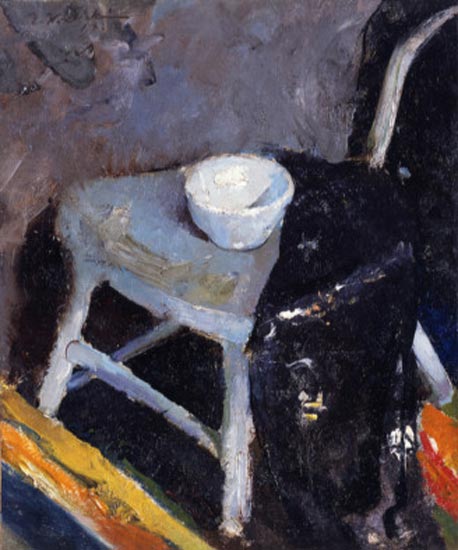
Studio Still Life, Provincetown 1914, Oil on canvas 24″ x 20″
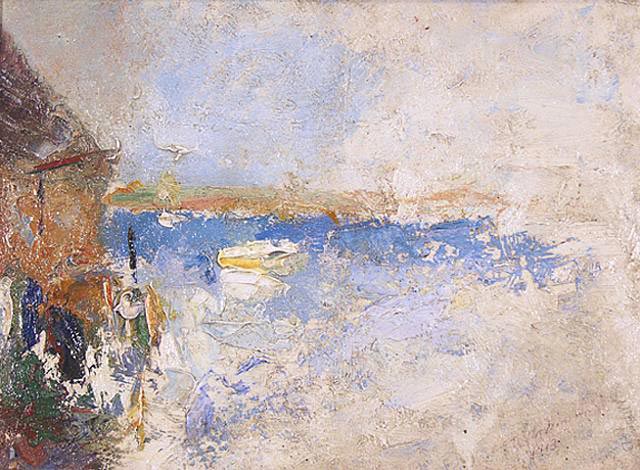
O’Neil’s Wharf 1913 Oil on Board 24″ x 16″





A wealth of information here, Larry – thanks for taking the time to post it. I saw “Dreams and Realities” in Philadelphia and I frequently return to the catalog. Just this morning I used his mudhead self portrait in a still life class to show students what Hawthorne meant by seeing and painting spots of color instead of getting carried away by details. It was a delightful coincidence to log in this afternoon to see your article!
Thanks for your comment Robert! There is such an amazing amount to learn from his work and teaching – this hardly scratches the surface but hopefully it might inspire people unfamiliar with him to investigate further. Your students are lucky to have you for a teacher. I was just checking out your blog by the way – terrific work there.
Thanks for this post. There’s lots of information here that I didn’t know about. It’s funny, but I’ve been thinking about Dickinson lately myself, and just last week, ordered Edwin Dickinson: A Critical History of His Paintings. I Think you’ll like it. There is a lot of information about his approach, technique and teaching.
A few years ago, I took a one-day class on his premier coup approach. I don’t remember the man’s name who taught it, but he was quite old—I’m saying this because I don’t remember if he’d actually studied with Dickinson or not.
The working method makes a lot of sense in practice.
Thanks for your comment Tom,
I would be interested to know who gave that class or more about it – sounds intriguing. I wonder how many of his former students are still out there painting.
I feel like the fortunate one. It’s an adult, non-profit art center class and my first experience teaching. Dickenson and Hawthorne are great ghosts to conjure up for help. They were both gifted teachers. Didn’t George Nick spend about ten years off and on studying with Dickenson?
Robert,
I’m not sure how long George Nick studied with Dickinson but I know it was at the Art Students League, 10 years seems maybe a little long but I might have been longer than usual as it was probably less formal. On George Nick’s website (which I made for him) you can see a painting Nick made while studying with Dickinson – it’s the still-life with apple and sheet in 1959. Another student of Dickinson who seems to pass on Dickinson’s teachings was Lennart Anderson, who taught (teaches?) at Brooklyn College. A number of painters I’ve looked at on this blog studied with Lennart Anderson (and I there are a few more I want to post about)
Great post. I think of Dickinson as being someone like a modern Giogione, rooted in realism and representational art but so very mysterious. ‘The Artist’s Hand’ is so specific and tangible yet so ethereal at the same time.
nice little ‘family history’ here: eve mansdorf who studied with lennart anderson who studied with edwin dickinson. it would be fun to carry this one further.
well, Dickinson studied with Hawthorne who I posted about awhile ago – so that is carrying it a tad further. Hawthorne in turn studied with William M Chase (as did Dickinson) and Chase studied with Jean-Léon Gérôme who in turn studied with Delaroche who in turn palled around with Théodore Géricault and Eugène Delacroix. (don’t know if any Corot connection but it would be nice) In the other direction in time, Eve Mansdorf teaches at Indiana University, not sure if any of her students are yet ready to enter the hall of fame yet – but one can hope.
Hi Larry:
I think the landscape you have below the painting of the artist’s hand holding a children’s drawing is sideways.
Dickinson can get abstract but those are buildings, trees and sky if I’m not mistaken.
I recommend the catalog from the Provincetown Art museum. Call them up and get one mailed to you.
Back before the San Francisco museum embedded all their images within web pages so that they could not be downloaded I wrote a program that grabbed their image of the Cello Player which is in VERY HIGH RESOLUTION. Beautifully photographed! Its a slow download but worth it for anyone who wants to look at this painting in close detail.
Follow the link from Edwin Dickinson description from this URL:
http://davidmarshall.us/links.html
I’ve always found some E.D.’s premier coups perplexing. Stuart Shils gave a very good lecture about his take on Dickinson. In short, its what one sees in a glance. Its that moment when one’s eyes have not fully adjusted and one’s mind has not started naming objects. Color is generally kept to a minimum, edges can be very soft or hazy. Its sort of the overwhelming of the visual sense that one might get from stepping from the indoors into the bright sunlight. Consequently our desire to see nameable objects or a subject in the painting is obfuscated.
Hi David,
That painting “Studio Wellfleet” – might be hanging sideways, it was positioned that way from the On the Babcock Gallery website – they have it shown sideways and I guess I didn’t really look at it hard enough as the tree and sky do seem to be the wrong way. But I just now tried rotating it 90 degrees counter-clockwise and it totally looked wrong. I’m a bit unsure now – but will leave it the way I found it.
I understand that people hanging Dickinson’s work would occasionally hang a few the wrong way as well.
I was going to post a link to your High Resolution Cello Player but I forgot – thanks for the link and the suggestion. It is an awesome image, I was thinking of printing it out and making myself a poster from it. I’ve been using it as my desktop image on my laptop. Thanks for making that available. Didn’t you write an article about Stuart Shills and Dickinson’s studio – I couldn’t find it on your website just now.
Hi David,
I can’t seem to find the Edwin Dickinson Cello Player image for download on the link included. Would you be able to located it for me? I would love to have it.
Best,
Josiah
I think what may be throwing people off is that the signature on this painting runs up the side which he often did. When I rotated it 90 degrees CCW the painting at least seemed rational but certainly has some puzzling elements like those box like forms (stairs) at the bottom. The white sand seems to be tipped flat with the picture plane.
This is a classic example of an E.D. premier coup that leaves one wondering if the Emperor is wearing clothes. If I saw it in a junk store in beat up frame for $10, I’m not sure I’d buy it.
Lennart Anderson found his Dickinson painting in just this way. Its reproduced in the Provincetown catalog.
Hello Larry,
This is a wonderful site. Just the thing to bring together a community of similarly obsessed souls, spanning a very wide geographical area. I wanted in particular to thank you for linking to the Dickinson interview with Dorothy Seckler. I just read it now for the first time–fascinating!
Thanks Elana! I just took a look at your website, some awesome painting you are doing! I loved you still-life with clown and your figures are wonderful. Hope to hear more from you here as you get the chance. I see you went to the Jerusalem Studio School, Rebecca Harp, from the JSS post comments here on occasion and has been a supporter of this site – wonder if you might know her?
It’s nice to have Dickinson brought to my attention again. I looked at him a lot in school, but clearly I need to look again.
HI
Great information on Dickinson.
Actually, Chase didn’t study with Gerome, but studied in Munich instead. Here’s the Wikipedia link to his bio. The boldness and brushy quality of Chase’s still life paintings and Hawthorne’s early work don’t seem very Gerome-like.
http://en.wikipedia.org/wiki/William_Merritt_Chase
Thanks Arthur,
I’m not sure where I got that Chase studied with Gerome, I must have read it wrong – sorry for the sloppy information in that comment. Good to know some people out there a paying attention to the details!
It was bugging me where I read that about the Gerome connection with WM Chase. I found it on the wikipedia page that Arthur Remes post in the earlier comment. However, Arthur’s point is still valid as Chase didn’t study with Gerome directly, he studied with an earlier teacher (before his Munich study) who had studied under Gerome… and true that little evidence of Gerome’s style is evident in Chase’s painting. I quote from the wikipedia:
“After a brief stint in the Navy, Chase’s teachers urged him to travel to New York to further his artistic training. He arrived in New York in 1869, met and studied with Joseph Oriel Eaton for a short time, then enrolled in the National Academy of Design under Lemuel Wilmarth, a student of the famous French artist Jean-Léon Gérôme.”
I find Edwin’s work a true inspiration for photography.
I was employed at an Art Center when he was living and we posted a few of his paintings there. I really did not know that much about him at that time. His work is varied and this variance I find refreshing and yet intriguing.
One of few things I really like about living in San Francisco is probably being able to see the Cello Player whenever I want. It is just such a stunning piece.
I would really like to purchase a high-quality reproduction…like in Giclee or something.
Hi Barry, I didn’t realize that the Cello Player was in SF, next time I get up that way I’ll have to go see it. Where is it? Does the museum have a reproduction? I know David Marshall has a fairly high resolution version of it, not sure if it’s high enough for a good Giclee – maybe I’ll try and find out, I have a printer that can do that but is such a pain to get right I hardly ever use it…
Yes. Cello player is in De Young Museum, San Francisco.
In my opinion , the best work in the entire museum.
Maybe they do have a reproduction, but I can’t remember. I am looking for a large size reproduction though…
http://catnip.cs.umass.edu/Artists/dickinson/CelloPlayerBig.jpg
Got it from the museum many years back. I had to download 1000s of little jpegs and reassemble them.
At the time it didn’t get any better than this.
David’s link to the high resolution jpeg is certainly high enough resolution to print a gliclee or poster sized image. If you know photoshop at all you can make it even higher resolution by using a plug-in called Genuine Fractals, this plugin will allow you to take a higher resolution image such as this and make it big enough to print a very large poster (life-sized) if you want, with no loss in detail or quality. They used to have a free trial demo that allowed you to save the image for the first 8 or so images. But even without the plugin the file size is enough to print 11 x 14″ at 300 dpi. or 17 by 21″ at 200 dpi.
Thanks for the link David
Your use of copyrighted images of works of art owned by others without permission is unprofessional, illegal, and completely undermines your credibility on many levels. I suggest you withdraw, get proper permissions, and re-submit.
Hi John,
I’m sorry you feel this way. My goal for this blog is to bring greater awareness to the wide varieties of modern perceptual painting. Also to help expose great painters work to other painters so they may learn and be inspired by the information, images and links. I am not a art historian, critic or scholar, and don’t tend to follow their conventions, I am a painter with a blog – I don’t consider myself a professional.
I personally contact most, but not all, of the artists on my blog to get their permission to use their images. Normally this site focuses on living painters but Edwin Dickinson is an exception. As he is no longer with us I have no problem sharing images of his work with other painters – as is quite common on other blogs and other internet venues. I’m sure that technically you are correct that these images of his work are copyrighted and some lawyer somewhere or other person similarly inclined may take issue with this common practice. However, in the real world this is unlikely to offend anyone.
If I were to try to pass them off as my own work, try to sell them or display them for some other less noble cause then you might have a case. But as far as I know this would fall under the “fair use” clause or whatever it’s called. I’m not a lawyer – I’m a painter.
I am surprised that you would want to accuse me of being unprofessional and with no credibility for trying to educate and expose to a broader public about Edwin Dickinson. I would think it would be in your best interest as a representative of a gallery, that I understand has represented Edwin Dickinson, to get more interest in his work and potentially future clients. Especially since he has gotten such short shrift in the artistic community at large.
I will discuss this further with other people that know more about this issue than I. But for the time being I choose to keep everything the way it is.
I am surprised no one has linked the Cape Cod School and Henry Hensche to Dickinson. The Studio Still Life looks like something from that school of painter’s. Dickinson was amazing, this is a very useful resource site. Thank you for your efforts.
Great website. Very glad I discovered it. Easily the best painter’s forum I’ve ever run across on the internet. I’m not a “realist” painter, but I’m an old painter and familiar with many of the artists you’re exploring. I’m learning a lot from the interviews about them and the links back through time to the American realist tradition.
I just wanted to add here that the Studio Wellfleet looks correct to me. You can also see that he’s incised 1947 in the lower left corner which would seem to establish that as the correct orientation.
Really wonderful reproductions of work by Dickinson I’d never seen, particularly the more colorful ones at top and bottom. Thanks for your all your hard work, Larry.
Jon
I think your observation is spot on. The still lifes look to have a similar look. Dickinson also studied with Hawthorne – I think it was about 10 years(?) earlier around 1914 so it’s entirely possible that they knew each other too. Thanks for the observation and I will certainly be taking a look at Henry Hensche’s work.
Hi I have a painting by E Dickinson on the back of the painting it says miner 63 and spectators is there any record of this work?
Hello Robert, I am not sure how I arrived at your site this morning but I am so glad that I took the journey into your thoughts and postings. So much to think about. Mary Abell’s essay was wonderful. I downloaded it to continue referencing and thinking about the points she puts forth about Dickinson’s work. Having just finished reading an essay on O’Keefe I am intrigued by learning more about Dickinson and other “solitary painters” who prefer to isolate themself away from the maddening crowd in order to discover their inner self and commune on a more intimate level with the landscape.
I am a landscape painter. I do prefer to work alone. I work primarily on site but my vison is very representational in the sense that the object and the particular sense of place is immediately recognizable as I want it to be. I am not, however, interested in my work being simply reportage. From the images you have posted here I can see Dickenson’s work undeniably has elements of the image but it is his psychological immersion into the subject matter that connects his vision to some other inward reality. I love the fact that he was a student of Chase. My own vision is more in line with the painterly yet clearly recognizable image that Chase so magically produces. I must say though, that I am intrigued by other less naturalistic interpretations such as Dickinson’s images and hope to be able to see his work first had. Thank you for all of the information.
If anyone is still reading this – -could you please post the 1949 self-portrait of Dickinson done from
a side angle, from the shoulder to a profile, with part of the ceiling showing. This image is on the cover of the catalog, Edwin Dickinson, Draftsman/Painter, organized by John Dobkin for the National Academy of Design. If the image is posted, can someone please explain how Dickinson created the painting from that angle. Incidentally, in the catalog, dated 1982, The Cello Player is listed as being in a private collection. Do you know when and how the DeYoung acquired it? Or is it possibly on a long-term loan to the DeYoung? Thank you.
Hi Lyndia, Thanks for your comments,

Here is not only the image but the catalog cover, how’s that for service!
I can’t say for sure but I’ve tried painting a self-portrait in a similar pose using two mirrors angled in such a way as to get that view point.
I don’t know the details you’re asking about with the Cello Player but if you haven’t already seen it there is a new, fairly extensive wiki on Edwin Dickinson that you might find interesting. John Ward’s book Edwin Dickinson: A Critical History of His Paintings. Newark: University of Delaware Press, 2003 is another very good resource.
Have you seen the book of his drawings? If you haven’t and you’re curious let me know, I can help fix that.
(sorry I haven’t responded sooner to your comments here – I read the comments but sadly I don’t always have the time to reply. This is all a labor of love for the most part that I try to fit in-between my own painting, work and life. Someday I hope to get more time so I can join in the conversations more.)
Larry:
Thank you so much re the Dickinson portrait! I live in Bloomington, Indiana and we have excellent
resources for art books, inc. the IU Fine Arts Dept bookstore, so I will check them out first.
Hawthorne, Dickinson, Chase (from Indiana), Porter, Arthur Dow, Porter, et al are “my ancestors.”
I studied with Dickinson for several years in the early ’60s at The Art Students League. I learned a lot but he was disappointed when I did not follow his style. He was no longer painting by this time.
Cello Player image is now located at http://chinacat.cs.umass.edu/Artists/dickinson/CelloPlayerBig.jpg
I studied with Mr. Dickinson at the Art Students League in 1957 &8 &9. And was his monitor for 2 of those years. I also moved him from studio to studio,in Manhattan, painting the walls of the studios “Manet Grey”, ( i.e. middle value,, to keep
too much reflected light away from entering the shadow side).In 1980 I went to Lennart Anderson’s to give an interview to
someone who had been a student of a Dickinson student. He wanted to tape record what I & Charles Kamin, & Arthur Cohen, had to say about Dickinson as a teacher. The tape recprder was placed too far away(as it turned out) to be heard.
I told Mary Abell that I would try to figure out the tape that she gave me, but it was too inaudable. So many years later,in 1995 I made a video at the Spring Studio about Dickinson’s teaching. This did not turnout well,for various reasons. So in
( I think 2003 or 4) I did it again at the same place, and for those who are interested it is on my web-site,on the upper
left corner titled Lecture, & can be downloaded by anyone. I wish it were better, but it is what it is, & I hope it helps.
I have a portrait of my sister done by Edwin Dickinson. David Wise wrote that he had found two paintings in a dumpster by Carol Cleworth, my sister, who studied with Fickinson. Was David replying to John Leavey?
I studied at asl w/ mr Dickinson in 1965-66….I racall his humorous remarks when asked if he would rather have the last 1 man show at the old whitney or wait to hav the 1st show at the newer gallery….he told them he might not be around to see the new museum and chose that last show in the old building
he admonished the students to “get to bed at some hour ” so to rise in the morning and be ready for fruitful day of painting …..in general to be regulated….he several times mentioned that using the thick paint and knife technique was to avoid ‘happy accidents’
thanks to john leavey for reminding us of many of
the instructions …